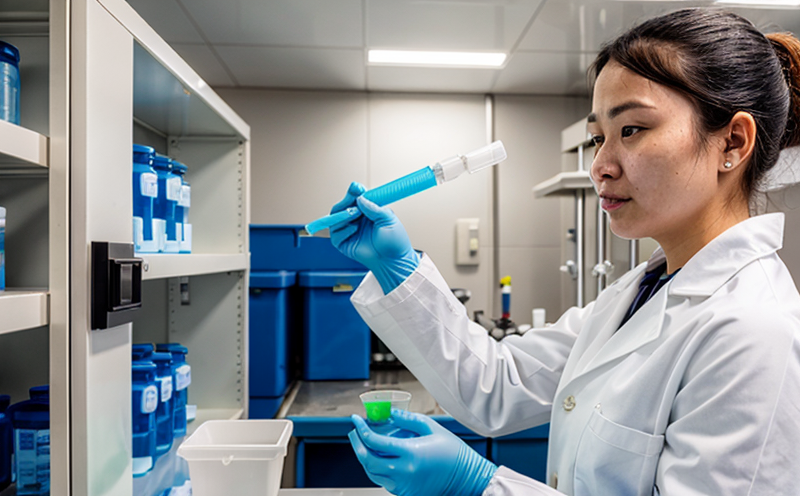USP Antibiotic Microbial Assay Testing
The USP AMT is a critical component of pharmaceutical testing that ensures the purity and safety of antibiotics. This method, as defined by the United States Pharmacopeia (USP), aims to measure the potency of antibiotics through microbial assay techniques. Antibiotics are life-saving drugs used in treating bacterial infections. However, their effectiveness can be compromised if impurities or contaminants are present. The USP AMT ensures that these drugs meet stringent quality standards set forth by regulatory bodies.
The test involves inoculating a known quantity of the antibiotic with a suspension of microorganisms (such as Bacillus subtilis for penicillin and cephalosporins, or Pseudomonas aeruginosa for carbapenems). The growth of these microorganisms is then quantified by measuring turbidity in the test solution. This process allows laboratories to determine the exact amount of antibiotic present per unit weight or volume.
The USP AMT plays a vital role in pharmaceutical development and quality control, particularly for:
- Developing new antibiotics
- Ensuring batch-to-batch consistency
- Compliance with regulatory standards
- Detecting potential contamination during manufacturing processes
In the context of the pharmaceutical industry, the USP AMT is not just a compliance measure but also an essential tool for ensuring patient safety. By accurately measuring antibiotic potency, laboratories can help prevent overdosing or underdosing, both of which can have serious health implications.
The methodology behind USP AMT has evolved over time to accommodate new technologies and standards. The latest versions of the USP guidelines incorporate advances in microbiology and analytical chemistry, ensuring that the test remains robust and relevant. This continuous improvement process is crucial for maintaining high-quality pharmaceutical products worldwide.
Pharmaceutical companies rely on USP AMT as part of their quality assurance programs. By integrating this testing into their manufacturing processes, they can identify potential issues early in development or production, thereby reducing the risk of recalls and ensuring product consistency across different batches and locations.
In summary, the USP AMT is a vital component of pharmaceutical testing that ensures antibiotic potency and purity, contributing to patient safety and regulatory compliance. Its role extends beyond simple measurement; it serves as a cornerstone for innovation in drug development and manufacturing processes.
Scope and Methodology
The USP AMT is designed to assess the antifungal potency of antibiotics, specifically penicillins, cephalosporins, carbapenems, and other β-lactams. It involves inoculating a known quantity of antibiotic with a suspension of microorganisms and measuring the growth of these organisms over time.
The primary apparatus used in this testing includes:
- Microtiter plates
- Bioreactor systems
- Turbidity meters
The methodology typically begins with preparing a standardized inoculum of the microorganisms. This inoculum is then incubated alongside different concentrations of the antibiotic being tested to observe its effect on growth inhibition.
Acceptance criteria for USP AMT include:
- Potency expressed as a percentage relative to a reference standard
- Absence of visible turbidity in the control wells
- No significant deviation from expected potency values within the batch or across batches
These criteria ensure that only high-quality antibiotics reach the market, meeting both regulatory and clinical standards.
In summary, the USP AMT provides a standardized approach to measuring antibiotic potency through microbial growth inhibition. This method is essential for ensuring product consistency and patient safety in pharmaceutical manufacturing processes.
Environmental and Sustainability Contributions
The USP AMT has several environmental and sustainability contributions that are worth highlighting:
- Eco-friendly practices: The use of standardized inocula minimizes the need for large-scale cultivation of microorganisms, reducing waste.
- Sustainable resource management: By ensuring high-quality antibiotics, USP AMT reduces the likelihood of ineffective treatments, which can lead to increased antibiotic usage and resistance.
- Regulatory compliance: Adherence to stringent standards helps pharmaceutical companies comply with environmental regulations and reduce potential harm from substandard drugs.
In conclusion, USP AMT not only supports the development of safe and effective antibiotics but also contributes positively to environmental sustainability by promoting efficient use of resources and reducing waste. This ensures that the industry remains both innovative and responsible in its approach to drug manufacturing.
Competitive Advantage and Market Impact
The ability to perform accurate USP AMT is a significant competitive advantage for pharmaceutical companies. It enables them to:
- Ensure product consistency across different batches and locations
- Detect potential contaminants early in the manufacturing process
- Maintain compliance with international regulatory standards
- Gain trust from healthcare providers and patients through consistent high-quality products
In a highly competitive market, pharmaceutical companies that can demonstrate their commitment to quality control and patient safety are more likely to succeed. USP AMT is a key tool in this regard, helping companies maintain a strong reputation and secure market position.





